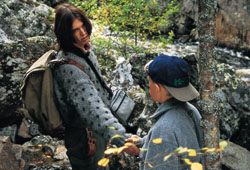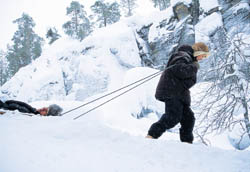Making the Film in Ranua and Posio
 Since the events in Tommy and the Wildcat were originally meant to take place in the North, Ranua Wildlife Park was a natural choice for us - after all, "the world's most northernmost wildlife park" is one of the film's central locations. Ranua is located in the Finnish province of Lapland. The municipality covers a vast area but is largely marshland and flat. However, the film was shot in the impressive wilderness scenery.
Since the events in Tommy and the Wildcat were originally meant to take place in the North, Ranua Wildlife Park was a natural choice for us - after all, "the world's most northernmost wildlife park" is one of the film's central locations. Ranua is located in the Finnish province of Lapland. The municipality covers a vast area but is largely marshland and flat. However, the film was shot in the impressive wilderness scenery.
Already when we were only developing the story, I toured Ranua together with Matti Haapanen and the neighbouring municipality Posio, where there were greater differences in elevation. There we found a good setting for the story: Korouoma, which is one of Eastern Europe's largest depressions. Korouoma canyon is at its deepest nearly 100 metres deep. It is almost 20 kilometres long.
When the financing for the film began to be secured, the directors inspected shooting locations at Korouoma with cinematographer Kari Sohlberg and production designer Pertti Hilkamo. We were convinced of its beauty. The only worry was that it was so far away from everything. Far from Ranua, far from Posio, far from the main road. The highest cliffs and deepest canyons were over ten kilometres away from the main road and more than a kilometre away from the nearest forest road.
Moving Limb and Equipment in the Wilderness
It was awkward moving in the forest during the autumn. Enormous boxes of equipment had to carried to the site since all - terrain mobiles simply couldn't get past the marshland, precipices and rock clusters. Dragging a bullcrane (camera crane) to the highest point of Korouoma, Purnuvaara, was an immense undertaking that required a group of 20 people and took one entire day. And when the cameras and actors arrived, the sky began to cloud over. At the last moment, we got the camera running, the "crane" reached out toward the sky and we caught the last rays of sun on film. The take only required a few minutes. And then we carried all the equipment back again.
During the winter shoot, it was slightly easier to move. One could reach even the more inaccessible places without having to carry any gear. Snow mobiles took us virtually anywhere we wanted. But riding a snow mobile could be tough going: at high speed the wind and snow whipped your face. And if you were being pulled in the sled behind, you got exhaust fumes in your face and your rear beat against the ground in uneven terrain. The local reindeer herdsmen who drove the snow mobiles had to make dozens of new paths to our locations.
However, the snow mobiles were at the mercy of the weather. When temperatures fluctuated the snow mobile paths became so soft that the heavy vehicles would get stuck in the two - metre snow drifts. We had to reduce the payload, which meant even/thing took more time. The snow mobiles and sleds behind could only take a limited number of people and as we had to transport our equipment as well from cameras to tracks, and not forgetting food for 40 people, the reindeer herdsmen were constantly driving back and forth.
Untrodden Snow
 Conditions in winter were much harder in more ways than one. We were prisoners of the snow. We needed shots of untrodden snow on which a person or animal walks, or a snow mobile drives. This meant there was not much chance for rehearsals. The first take became really vital. If we failed, it meant shifting location and finding a new suitable snow drift. There were no great disasters with people but when the wildcat was supposed to stroll into a wide shot, jump or run from point A to point B, the whole camera crew held their breath and were prepared to promise anything if it did what it was supposed to do. Well, it didn't work out many times, but the effort put into it can very well be seen in the film.
Conditions in winter were much harder in more ways than one. We were prisoners of the snow. We needed shots of untrodden snow on which a person or animal walks, or a snow mobile drives. This meant there was not much chance for rehearsals. The first take became really vital. If we failed, it meant shifting location and finding a new suitable snow drift. There were no great disasters with people but when the wildcat was supposed to stroll into a wide shot, jump or run from point A to point B, the whole camera crew held their breath and were prepared to promise anything if it did what it was supposed to do. Well, it didn't work out many times, but the effort put into it can very well be seen in the film.
Ville Suhonen
Co - director, screenwriter

